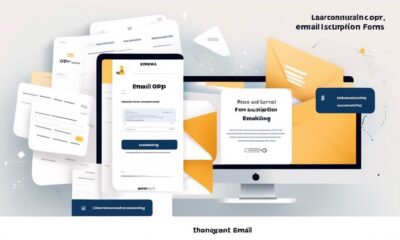How to Write Email
How to Write a Polite ‘Please Note’ in Your Email
Discover the art of crafting the perfect "Please Note" in emails, and learn how a simple phrase can shape your message—intriguing insights await!

When writing ‘Please Note’ in an email, it can be challenging to strike the right balance of formality and politeness. The language we use for these simple words can greatly affect the overall tone of our messages, so it’s important to choose our words carefully.
By understanding the nuances of alternative phrases like 'Be mindful of,' 'Kindly note,' and 'Pay attention to,' we can elevate our communication to a more professional level. However, there are subtle intricacies in their usage that can make all the difference in how our message is received.
Key Takeaways
- Polite alternatives to 'Please Note' enhance clarity and respect in email communication.
- Choose synonyms that convey the intended message with professionalism and clarity.
- Prioritize clarity and directness when using 'Please Note' to highlight crucial information.
- Avoid common mistakes like using 'Please Note' excessively without providing context or clear direction.
Crafting a Polite 'Please Note
Crafting a polite 'Please Note' message requires careful consideration to ensure the message is clear and respectful. When composing an email, it's essential to grab someone's attention in a formal way without sounding meek or condescending. An effective approach is to use alternative phrases like 'Be advised' or 'For your reference' to convey important information confidently.
Polite phrases such as 'Be mindful,' 'For your information,' or 'Bear in mind' can also serve as suitable substitutes to 'Please Note.'
To communicate the message in a professional way, consider using formal synonyms like 'Take note,' 'Note that,' or 'Please be aware.' These alternatives can help maintain a respectful tone while ensuring clarity. When using 'Please Note,' remember not to follow it with a comma and reserve its usage for formal contexts where drawing attention to specific details is necessary.
Crafting a polite 'Please Note' requires finesse and thoughtfulness to strike the right balance between clarity and respect.
For example, instead of saying, 'Please note the deadline,' one could write, 'Kindly take note of the deadline.' This subtle change maintains professionalism while conveying the required information effectively.
Choosing the Right Synonyms

When selecting synonyms for the phrase 'Please Note,' it's crucial to choose expressions that convey the intended message with clarity and professionalism. In formal emails, it's important to use language that's both respectful and clear.
Instead of simply saying 'Please Note,' some formal alternatives include 'Please be aware,' 'Keep in mind,' 'Take notice,' 'Pay attention to,' or 'It's important to recognize.' These phrases offer a more professional way to say 'Please Note' and can enhance the overall tone of your message.
In English lessons, it's often highlighted that using the correct formal synonym for 'please' can elevate the formality of your communication. Therefore, incorporating a formal synonym for 'please' when replacing 'Please Note' can further enhance the professionalism of your message.
Choosing the right synonym is essential in maintaining a formal tone in your correspondence.
Tips for Effective Communication
To enhance effective communication, we prioritize clarity and directness in our messages, fostering understanding and engagement. When incorporating the phrase 'please note' in your emails, it's important to use it strategically to highlight crucial information. Avoid common misconceptions by remembering not to add a comma after 'please note,' as it isn't an introductory clause.
Another polite and friendly alternative to 'please note' is 'kindly note,' which can add variety to your communication. It's essential to keep in mind that 'please notice' isn't a suitable substitute for 'please note' in professional correspondence.
When using 'please note' in your emails, make sure to provide a clear and concise explanation of why the information is important. For instance, in an email example, you could write, 'Please note that the deadline for project submissions has been extended to next Friday.' Additionally, always encourage recipients to let's know if they've any questions or need further clarification.
Common Mistakes to Avoid

In our pursuit of effective communication, we must remain vigilant in recognizing and sidestepping the common mistakes that can hinder clarity and understanding.
When crafting emails, it's crucial to pay attention to the information being conveyed. One common mistake to avoid is using 'Please note' excessively without providing context or clear direction. Instead of relying solely on this phrase, consider using a concise email example to show what you mean. For instance, you could say, 'Please note, the meeting time has changed to 3:00 PM,' to provide clarity.
Another mistake to avoid is emailing an employee without clearly stating the action required. Instead of just saying 'Please note,' it's correct to use a specific phrase to include the necessary information. For example, you could say, 'Please note, review and provide feedback by Friday,' to ensure the recipient understands what's expected. Remember to place a comma after the phrase to separate it from the main message and provide clarity.
Enhancing Email Etiquette
Enhancing our email etiquette involves recognizing the importance of choosing appropriate synonyms for phrases like 'Please Note' to ensure clear and effective communication. When using formal synonyms such as 'Kindly note,' it conveys a similar message while adding a touch of professionalism.
Pay attention to the tone and formality of your email closings as well. Avoid outdated sign-offs like 'Sincerely yours' and opt for more contemporary options.
When starting an email, skip over hollow pleasantries like 'I hope you're well' and instead, opt for more genuine greetings. For instance, 'Good morning' or 'Hope you'd a great weekend.'
By exploring the best ways to structure our emails, we can enhance communication and build stronger connections. Please provide specific details and examples to help clarify your message.
Always say thank you when appropriate and don't hesitate to contact us for further assistance.
Frequently Asked Questions
How Do You Say Please Note in an Email?
Sure thing! When we want to convey the importance of information in an email, using 'please note' is a great way to do so. It grabs attention without being rude and is appreciated by most recipients.
What Is a Better Way to Say Please Note?
Have we considered using alternative phrases when we want to convey the same message as 'please note'?
It might be beneficial to explore variations like 'kindly be informed', 'it should be noted that', or 'an important point to remember is'.
These alternatives can add variety and formality to our communications.
Let's enhance our language by utilizing these sophisticated alternatives in place of the common phrase 'please note'.
Is It Correct to Say Please Note?
Yes, it's correct to say 'please note' in formal communication. This phrase effectively draws attention to important information, prompting the reader to remember it.
It's concise and polite, making it a suitable choice for emails or letters. Remember, clarity is key in communication, and 'please note' helps achieve that goal.
Avoiding a comma after 'please note' maintains the intended impact of the phrase.
What Is an Example of a Please Note?
Sure thing!
An example of a 'please note' in an email could be:
'Please note that the deadline for submitting your report has been extended to next Friday.
Kindly ensure that all necessary revisions are made by then.
Thank you for your attention to this matter.'
This phrase effectively grabs the reader's attention and emphasizes the importance of the information provided.
Can I Use the Polite ‘Please Note’ in My Proposal Email to My Boss?
When writing a persuasive proposal email to your boss, it is completely appropriate to use the polite phrase “Please note” to bring attention to important details. This can help emphasize key points and ensure that your proposal is effectively communicated.
Conclusion
In conclusion, let's kindly note that using 'please note' in emails is like sprinkling a touch of elegance on your communication.
It's the cherry on top of your message, reminding recipients to pay attention without sounding too demanding.
So next time you craft an email, remember to incorporate this polite phrase for a touch of finesse.
Happy emailing!
Erik – Email, SEO, AI Expert Writer Erik is the strategist, the thinker, and the visionary. His role at Influenctor is pivotal in integrating SEO with AI-driven content strategies. With an extensive background in email marketing and a profound understanding of search engine algorithms, Erik develops innovative strategies that elevate our client’s online presence. His work ensures that our content is seen, felt, and remembered.
How to Write Email
Crafting a Polished PTO Request Email
Need guidance on crafting a professional PTO request email? Learn key tips and essential components to ensure your request stands out.

As professionals in our specific fields, we all understand the importance of striking a balance between our work responsibilities and personal lives.
However, when it comes to requesting PTO, it can be a delicate task to navigate. Finding the right balance between being concise and providing all necessary information can be challenging, but it’s essential for a successful request.
In this discussion, we’ll explore the key components of crafting a well-written PTO request email, ensuring that your request is clear, professional, and respectful of your supervisor’s time.
Key Takeaways
- PTO plays a crucial role in maintaining work-life balance and employee well-being.
- Open communication with managers is essential for effective leave planning.
- Crafting a well-written PTO request email involves using a clear subject line, stating the reason for the request, expressing gratitude, and offering assistance during absence.
- PTO management tools simplify the process of requesting and managing leave, reducing scheduling conflicts and ensuring adequate staffing.
Understanding PTO and Its Importance
Understanding the significance of PTO in maintaining a healthy work-life balance is crucial for both employees and the overall company culture. PTO, or paid time off, plays a vital role in ensuring that employees have the opportunity to rest, recharge, and tend to personal matters without compromising their financial security.
It’s important for employees to have a clear understanding of PTO policies, which are typically outlined in the employee handbook or company policy documents. Open communication with managers or supervisors regarding PTO usage is essential for planning leave requests effectively.
By recognizing the importance of work-life balance, employees can proactively manage their time off, providing ample notice for planned absences and ensuring minimal disruption to workflow. Furthermore, a company culture that values and encourages the use of PTO fosters employee well-being, satisfaction, and productivity.
It’s crucial to acknowledge the correlation between taking time off and preventing burnout, as well as the positive impact it has on overall job performance and satisfaction.
Crafting a Clear and Persuasive Email

Crafting a clear and persuasive email to request PTO requires careful attention to detail and a thoughtful approach that effectively communicates the need for time off. Start by crafting a clear and concise subject line that summarizes the purpose of the email.
When writing the body of the email, clearly state the reason for the PTO request, including specific dates and the type of leave being requested. It’s important to provide a brief explanation of the importance of the requested time off, emphasizing the positive impact on work-life balance and overall well-being.
Express gratitude and maintain a professional and respectful tone throughout the email.
End the email with a willingness to discuss the request further and offer assistance in ensuring a smooth transition during the absence. This approach helps to ensure that your email is persuasive and effectively conveys the need for time off to your manager or team.
Tips for Writing a Professional Email
When requesting PTO, it’s essential to maintain a professional tone and adhere to specific guidelines for crafting a clear and persuasive email. Here are some tips for writing a professional email to request vacation time off.
Firstly, ensure the subject line clearly indicates the purpose of the email, such as ‘Request for PTO: [Your Name].’ This helps the recipient understand the email’s content at a glance.
Next, address the recipient with a formal salutation, using ‘Dear [Manager’s Name]’ or ‘Hello [Manager’s Name]’ to maintain professionalism.
In the body of the email, clearly state the purpose of the email, including the dates for which you’re requesting PTO and any pertinent details related to your request. Be sure to adhere to company policy and provide ample notice if required.
Use polite and respectful language throughout the email to convey your request professionally.
Finally, close the email with a professional sign-off, such as ‘Sincerely’ or ‘Best regards,’ and include your contact information for further communication if necessary.
Examples of Effective Time Off Request Emails

We are writing to request time off from [specific start date] to [specific end date] for personal reasons. According to our company’s vacation policy, we understand the importance of providing advance notice and making a formal request for vacation time.
To ensure a successful request, it’s crucial to write a vacation request email with a clear subject line and a professional tone in the body of the email. When composing the email, it’s essential to clearly state the reason for your vacation and adhere to the specific dates required. Additionally, it’s important to adhere to the company’s vacation policy and any specific procedures outlined for requesting time off.
- State the specific dates for the requested time off.
- Clearly outline the reason for the time off.
- Express gratitude for the consideration of the request.
Simplifying Time off Requests With PTO Tools
By utilizing PTO management tools such as Flamingo, companies can streamline the process of requesting and managing leave, allowing employees to submit their requests directly from Slack and enabling managers or supervisors to promptly approve or deny them while maintaining an updated leave calendar. This simplifies time off requests, creates a paper trail, and ensures that the vacation policy is adhered to. PTO tools like Flamingo also make it easier for employees to let their manager know about their vacation plans, reducing the likelihood of scheduling conflicts and ensuring that the team is adequately staffed at all times. The use of these tools helps in avoiding the back-and-forth of vacation request emails and sample vacation request emails, making the entire process efficient and transparent. Here’s an example of a simplified time off request process using PTO tools:
Benefits of PTO Tools Streamlined process Direct Slack submission Prompt approval/denial
Frequently Asked Questions
How Do You Write a Formal Email Request?
We write a formal email request with a clear subject line, specified dates, and a friendly tone.
Understanding the benefits of PTO and its impact on work-life balance is crucial.
Providing a status update upon return and arranging coverage during absence are essential.
Familiarizing ourselves with company policies, considering paid versus unpaid time off, and asking for time off at the right time are necessary.
We express willingness to address concerns, be polite and appreciative, and provide assurance that work will be covered.
How Do You Write a Day off Request Email?
When writing a day off request email, we keep it professional, brief, and polite. We express gratitude for the opportunity and clearly state the dates and reason for the request.
We ensure the recipient understands that we’ve considered any potential impact on work and have a plan to address it. It’s crucial to follow any specific company procedures for requesting time off and to be open to discussing any adjustments if needed.
How Do You Politely Ask for Leave in an Email?
When politely asking for leave in an email, we ensure to be concise, providing specific dates and reasoning. We maintain a professional tone and express gratitude for considering our request.
Including a subject line that clearly states the purpose aids in effective communication. It’s important to highlight our commitment to completing pending tasks and offering a plan for coverage during our absence.
Clear communication helps in getting our leave approved.
How Do I Request a PTO Email Example?
Sure, requesting a PTO email example is a common need. We can provide a clear and professional sample that you can use as a template.
It’s essential to tailor it to your specific situation and company culture. We’ll include a polite tone and necessary details for an effective request.
This example will serve as a helpful guide for crafting your own PTO request email.
Conclusion
In conclusion, requesting time off is an essential part of maintaining a healthy work-life balance. By following the tips and examples provided, you can craft a persuasive and professional PTO request email that will help you secure the time off you need.
Remember to be proactive in preparing for your absence and to show appreciation for your supervisor’s understanding. With the right approach, you can make the process of requesting time off as smooth as butter.
Erik – Email, SEO, AI Expert Writer Erik is the strategist, the thinker, and the visionary. His role at Influenctor is pivotal in integrating SEO with AI-driven content strategies. With an extensive background in email marketing and a profound understanding of search engine algorithms, Erik develops innovative strategies that elevate our client’s online presence. His work ensures that our content is seen, felt, and remembered.
How to Write Email
How to Write Effective Team Email Communications
Bolster your team communication with expert email writing tips that will enhance productivity and collaboration like never before.

In today’s modern office settings, emails are now seen as the online version of a handshake when it comes to conducting business. It is crucial to carefully craft our emails as they can either help us succeed or result in confusion and miscommunication.
Mastering the art of writing emails to team members is more than just a skill; it's a strategic tool for fostering collaboration and productivity within our teams.
So, how can we ensure that our emails are not just another unread message in an overflowing inbox? Let's explore the key principles that can transform our emails into effective and engaging communication channels, ultimately strengthening our team dynamics and achieving our collective goals.
Key Takeaways
- Clear and concise communication through emails is crucial for avoiding misunderstandings and maintaining a positive company culture.
- Crafting engaging subject lines can increase open rates and set expectations for the purpose of the email.
- Conveying vital information in emails should prioritize essential details, maintain transparency, and be free of errors.
- Fostering a positive team dynamic involves promoting collaboration, transparency, regular communication, and professionalism in emails.
Importance of Clear Communication
Clear communication via email is crucial for avoiding misunderstandings and maintaining a healthy company culture. When crafting professional emails, it's essential to be clear and concise to ensure that the intended message is effectively conveyed.
Our communication skills, reflected in the emails we send, play a pivotal role in engaging and informing our colleagues. A substantial percentage of employees ignoring work emails emphasizes the importance of writing emails that captivate and inform them efficiently.
By mastering the art of clear and transparent communication, we can foster trust and engagement among our team members, thereby positively impacting the overall workplace environment. The writing style of our emails significantly influences how the message is received and understood by the recipients. Therefore, it's crucial to maintain professional and consistent communication in emails to establish a positive and productive work environment.
As we delve into the intricacies of writing email to team members, honing our ability to craft clear, professional, and engaging emails will undoubtedly enhance our effectiveness in communicating within the organization.
Crafting an Engaging Subject Line

Mastering the art of clear and transparent communication through engaging subject lines is crucial for capturing our team members' attention and setting clear expectations for our emails. When crafting subject lines for our emails, we should keep in mind the following:
- Be Specific and Attention-Grabbing: Use subject lines that are specific to the content of the email and grab the recipient's attention. This can increase open rates and ensure that the email isn't overlooked in a crowded inbox.
- *Example*: 'Action Required: Review and Approve Q3 Budget Proposal'
- Clearly State the Purpose: The subject line should clearly state the purpose of the email, setting the right expectations for recipients. This helps in ensuring that the email is read and acted upon promptly.
- *Example*: 'Invitation: Team Building Event RSVP Needed by Friday'
Crafting engaging subject lines is an essential skill in writing professional emails. By using impactful language, being specific, and reflecting the urgency and importance of the message, we can increase the likelihood of our team members engaging with the content of our emails.
Conveying Vital Information
We consistently convey vital information to our team members through clear and engaging email communication, ensuring that important messages are effectively delivered and understood.
When writing employee emails, it's crucial to prioritize essential information, leading with the most critical details to grab attention and maintain the reader's focus. By using attention-grabbing subject lines, we can convey the urgency of the message and ensure that employees understand the importance of the content.
Maintaining transparency, positivity, and consistency in our communication helps to build trust and engagement with our team members.
Furthermore, ensuring that our emails are free of spelling mistakes, grammatical errors, and typos is essential for maintaining professionalism and credibility.
Clear and concise communication is key when conveying vital information, and it's important to craft emails that aren't only informative but also engaging and easy to understand. This approach fosters a healthy company culture and keeps employees actively involved and informed.
Fostering a Positive Team Dynamic

Fostering positivity within the team dynamic enhances collaboration and productivity. To achieve this, transparency about major developments and progress should be prioritized. Consistently sending regular emails fosters the habit of reading and engagement among team members, promoting a sense of unity and shared purpose.
Additionally, designing a template for important company-wide emails with a professional look can maintain branding and visual appeal, setting a positive tone for communication. Furthermore, ensuring that emails are free of spelling mistakes, grammatical errors, and typos is essential for quality assurance and to convey professionalism.
It's also crucial to consider the message, audience reaction, and audience size when deciding when to send an email, as this demonstrates respect for the recipients' time and attention.
Ensuring Professionalism and Clarity
How can we ensure that our team emails convey professionalism and clarity in every communication? To ensure our team emails maintain a professional tone and convey information clearly, we need to pay attention to several key elements. Here are some strategies to consider:
| Element | Description | Example |
|---|---|---|
| Clear and Specific Subject Line | Use a subject line that accurately summarizes the content and urgency of the email. | "Action Required: Review Meeting Agenda" |
| Professional Greeting and Introduction | Begin the email with a polite greeting and a concise introduction of the email's purpose. | "Dear Team, I hope this email finds you well. I am writing to inform you about the upcoming project." |
| Focused and Concise Body | Keep the email body focused on essential information, using short paragraphs and a clear call to action. | "Please review the attached document and provide your feedback by Friday." |
Frequently Asked Questions
How Do You Write an Email to the Whole Team?
When we write an email to the whole team, it's crucial to capture everyone's attention right from the subject line. We need to lead with the most important information and maintain transparency, positivity, and consistency in our communication.
This ensures that our message is clear and well-received by all team members. By following these guidelines, we can effectively communicate with the entire team and maintain a healthy company culture.
How Do You Write a Formal Email to a Staff?
We write formal emails to our staff members with a respectful tone and clear, concise language. We start with a polite greeting and then dive into the main subject.
Our message is professional, yet approachable, and we always include all necessary details. We ensure that our email is well-structured, error-free, and follows the company's communication guidelines.
Lastly, we end with a courteous closing and our contact information.
How Do You Share Information With Team Members Email?
When sharing information with team members via email, we ensure clarity, brevity, and positivity. We grab attention with an engaging subject line, using numbers or emotional language.
We lead with the most important information, maintaining transparency and consistency. Regular updates and a positive tone are crucial. We aim to avoid misunderstandings and effectively engage our employees, ensuring our emails are concise, organized, and impactful.
How Do You Write a Letter to a Team Member?
When writing a letter to a team member, we aim to communicate clearly and concisely to convey important information.
We should ensure that the subject line is specific and relevant, grabbing the recipient's attention.
Our goal is to maintain transparency and build trust through our correspondence. By doing so, we foster a healthy company culture and keep our team engaged.
Our emails should be brief, yet informative, to effectively share updates and progress.
Conclusion
In conclusion, clear and effective communication is the foundation of a successful team. By mastering the art of email writing, we can keep our team members informed, engaged, and motivated.
It's through transparent and positive communication that we can foster a strong team dynamic and maintain professionalism. So, let's keep our emails concise yet impactful, and always strive for clarity and consistency in our communication.
Erik – Email, SEO, AI Expert Writer Erik is the strategist, the thinker, and the visionary. His role at Influenctor is pivotal in integrating SEO with AI-driven content strategies. With an extensive background in email marketing and a profound understanding of search engine algorithms, Erik develops innovative strategies that elevate our client’s online presence. His work ensures that our content is seen, felt, and remembered.
How to Write Email
How to Write an Apology Email After Missing a Meeting
Master the art of crafting a compelling apology email for missing a meeting and mend professional relationships with finesse.

We’ve all been in situations where skipping a meeting is like missing the last puzzle piece. It’s not the end of the world, but it leaves a sense of incompleteness. Anyone can relate to that empty feeling. Don’t miss out on the opportunity to connect and collaborate with others. Joining meetings can lead to valuable insights and connections. Don’t miss the chance to be a part of the bigger picture.
So, how do we convey our apologies in a way that not only acknowledges the inconvenience caused but also sets the stage for a potential rescheduling?
Well, let’s explore the art of crafting an apology email for missing a meeting and how it can pave the way for rebuilding professional rapport.
Key Takeaways
- Apologizing and taking responsibility for missing a meeting is crucial in maintaining professional relationships and demonstrating accountability.
- Valid reasons for missing a meeting include personal emergencies, conflicting schedules, miscommunication of meeting details, technical issues, or forgetfulness.
- When apologizing for missing a meeting, reach out to the relevant parties as soon as possible, express sincere regret, offer a transparent explanation if applicable, and make amends by catching up on missed work or providing a summary of the meeting’s key points.
- To avoid future missed meetings, prioritize and organize schedules effectively, communicate potential conflicts in advance, utilize reminders and calendar apps, establish work-life boundaries, and take proactive measures to prevent future absences.
Understanding the Importance of Apologizing
Understanding the importance of apologizing is vital in maintaining professional relationships and demonstrating accountability. When we miss a meeting, it’s essential to acknowledge the significance of the gathering and offer a sincere apology. Taking responsibility for our absence and recognizing any inconvenience caused is crucial.
We must understand that our actions can impact others and acknowledging the importance of the meeting in our apology email is a way to show that we value the time and efforts of our colleagues. By offering an explanation, if applicable, we can provide context for our absence and show that we understand the impact of our actions.
Maintaining professional relationships requires us to be empathetic and considerate of others’ time. Therefore, understanding the importance of apologizing in this context isn’t just about saying sorry; it’s about demonstrating respect, accountability, and a genuine desire to make amends.
In doing so, we can repair any damage caused by our absence and work towards rebuilding trust and goodwill.
Reasons for Missing a Meeting

Apologies for missing a meeting can stem from a variety of reasons, including personal emergencies, conflicting schedules, miscommunication of meeting details, technical issues, or simply forgetfulness.
When crafting an apology email for missing an important meeting, it’s crucial to acknowledge the reason for the absence. A personal emergency, such as a sudden illness or family crisis, is a valid reason for missing a meeting. Conflicting schedules may arise due to prior commitments or unforeseen work demands. Miscommunication of meeting details, like time or location, can lead to unintentional absence. Technical issues, such as internet connectivity problems or software malfunctions, might prevent attendance despite the best efforts. Lastly, forgetfulness can cause an unintentional absence from a meeting.
Whatever the reason, it’s essential to sincerely apologize for missing the meeting, express understanding of the inconvenience caused, and offer to make amends. By addressing the specific reason for missing the meeting in a professional apology email, it demonstrates a commitment to maintaining a positive relationship and ensuring future attendance.
Steps to Apologize for Missing a Meeting
After acknowledging the various reasons for missing a meeting, it’s important to understand the steps involved in crafting a sincere apology email.
Firstly, reaching out to the relevant parties as soon as possible is crucial. Promptly acknowledging the absence demonstrates professionalism and respect for others’ time.
Secondly, the apology email should be sincere and apologetic. Expressing regret for missing the meeting and acknowledging the inconvenience caused can go a long way in rebuilding trust and maintaining positive professional relationships. Additionally, if there’s a valid explanation for the absence, it should be offered in a transparent and honest manner. However, it’s important to avoid making excuses and instead focus on taking responsibility for the missed meeting.
Making amends is another vital step in the process of apologizing for missing a meeting. Offering to catch up on missed work or providing a summary of the meeting’s key points can help mitigate the impact of the absence.
Lastly, following up after sending the apology email shows a commitment to rectifying the situation and ensuring that the relationship remains positive and professional.
Please accept our sincerest apology for any inconvenience caused by our absence at the meeting.
Apology Email Templates

We understand the importance of crafting sincere and empathetic apology emails when missing a meeting, and providing appropriate templates can help streamline this process for professionals.
When drafting an apology email for missing a meeting, it’s essential to show respect, express regret, and offer a brief explanation if applicable.
One template approach is to apologize for any inconvenience caused by the absence and express regret for not being able to attend. Additionally, it’s important to suggest alternative dates and times to reschedule the meeting, demonstrating a commitment to making amends.
Another template could involve expressing regret and acknowledging the inconvenience caused, while also offering to make amends by proposing alternative ways to catch up on the missed meeting points.
It’s crucial to maintain a professional tone throughout the email and thank the recipient for their understanding.
Maintaining Work-Life Balance to Avoid Future Missed Meetings
To maintain a healthy work-life balance and minimize the risk of missing future meetings, it’s crucial to prioritize and organize our schedules effectively. Balancing work hours with personal time is essential for honoring our commitments and showing respect for others’ time.
It’s important to communicate any potential scheduling conflicts with colleagues in advance, as this demonstrates our commitment to our professional responsibilities. Setting reminders and utilizing calendar apps can help us stay on top of meeting times and avoid forgetfulness.
Additionally, establishing clear boundaries between work and personal life can help prevent burnout and reduce the risk of missed meetings due to personal emergencies. By maintaining a work-life balance, we show our dedication to our work while also acknowledging the importance of personal well-being.
When it comes to addressing missed meetings, it’s crucial to avoid making excuses and instead take responsibility for the inconvenience our absence may have caused. This approach demonstrates professionalism and a proactive attitude towards preventing future missed meetings.
Frequently Asked Questions
How Do You Apologize for Missing Meetings in an Email?
We apologize for missing meetings in an email by promptly acknowledging the oversight, explaining the reason for our absence, and expressing our regret.
It’s crucial to convey sincerity and understanding while offering a solution to mitigate any inconvenience caused.
By taking responsibility and showing empathy, we can maintain professionalism and strengthen relationships with our colleagues.
Our approach should reflect genuine concern for their time and the impact of our absence.
How Do You Apologize Professionally for Not Attending a Meeting?
We apologize professionally for not attending a meeting. We acknowledge the inconvenience caused and express sincere regret. If applicable, we offer an explanation for our absence.
It’s important to convey gratitude for understanding and to assure the recipient of our commitment to preventing future occurrences.
Our email should maintain a polite and professional tone, demonstrating responsibility and respect for their time.
We aim to mend any disruption caused and reaffirm our dedication to the team.
How Do You Apologize Professionally in an Email?
We apologize professionally in an email by acknowledging our mistake.
We express genuine regret and offer a sincere explanation.
It’s essential to convey empathy and understanding for any inconvenience caused.
We should also assure the recipient that we’re taking steps to prevent a similar situation in the future.
How Do You Apologize for Missing Something Professionally?
We apologize for missing something professionally.
We acknowledge the mistake, expressing genuine regret.
We offer a sincere explanation if necessary.
It’s crucial to take responsibility.
We make amends and ensure it doesn’t happen again.
Communicating promptly and professionally with those affected is essential.
Conclusion
We sincerely hope that our article has been helpful in guiding you through the process of writing an apology email for missing a meeting.
Just like a warm hug on a cold day, a heartfelt apology can mend relationships and show our genuine care for others.
Thank you for taking the time to read our tips, and we wish you success in all your future professional endeavors.
Erik – Email, SEO, AI Expert Writer Erik is the strategist, the thinker, and the visionary. His role at Influenctor is pivotal in integrating SEO with AI-driven content strategies. With an extensive background in email marketing and a profound understanding of search engine algorithms, Erik develops innovative strategies that elevate our client’s online presence. His work ensures that our content is seen, felt, and remembered.
-

 Email Marketing Tools and Techniques1 month ago
Email Marketing Tools and Techniques1 month agoHow to Export Mailchimp Contacts
-

 How to Write Email2 months ago
How to Write Email2 months agoHow to Write Negative Feedback Email: Sample Guide
-

 Email Automation3 months ago
Email Automation3 months agoAutomated Email Marketing 101: A Beginner's Tutorial
-

 Marketing Strategy3 weeks ago
Marketing Strategy3 weeks agoHow to Make an Offer So Good That Customers Can’t Resist!
-

 Email Warmup3 weeks ago
Email Warmup3 weeks agoWarm Follow-Up Email
-

 GDPR Email Marketing4 weeks ago
GDPR Email Marketing4 weeks agoGDPR Email Marketing: Consent Examples Guide
-

 Email Design Hub1 month ago
Email Design Hub1 month ago3 Essential Tools for Email Marketing Design Success
-

 Email Marketing2 days ago
Email Marketing2 days agoWhat Is Email Marketing Advantages and Disadvantages


















